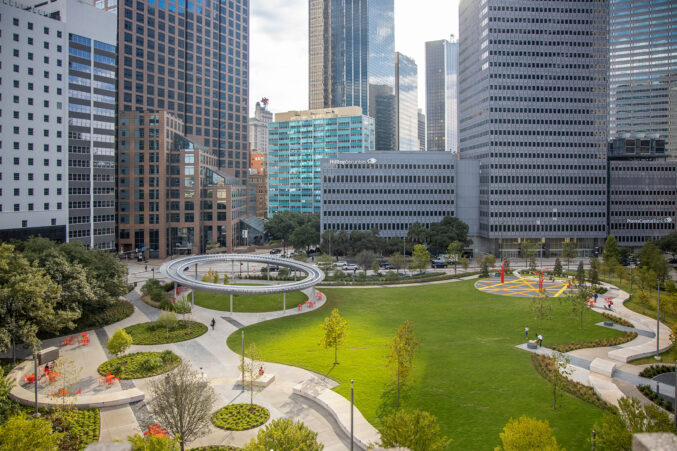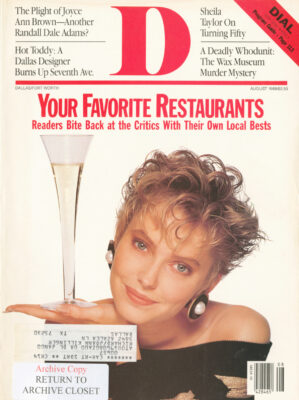Each summer, with the regularity of migrating swallows, Dallas-ites like the Strausses and the Murchisons, the Rooths and the Martinezes board private planes or Braniff jets and fly over the Continental Divide to San Diego. From there they drive fourteen miles to a 1ittle village on the Pacific called La Jolla and pronounced “la hoya” to “do the season.” These Texans are bent on getting dizzy with California mentality. And they seek a change in lifestyle that those left behind to swelter in Dallas may find somewhat perplexing. “But in La Jolla,” explains one longtime goer, “to summer is a verb.” And “to summer” correctly involves a transformation of Texas proportions, he says.
Big-money Texans, whose ranches and homes are measured out in acres, find it civilized to summer in a bungalow-seven people (maid from home included) in two bedrooms, our initiated source explains. They emerge from their pads dressed California rich and stroll to the closest caviar and oyster bar to pleasantly chat with people from New Jersey. And if they don’t take a private home, these departed Dallasites choose the La Jolla Beach and Tennis Club, long known as a most-popular dump replete with Day-Glo decor. Recently, though, explains one La Jolla B&T club regular, the hotel has spent “a fortune” renovating. “We’re very modern there now,” she says, “we’ve graduated from limes to aquas.”
This seasonal transformation to California cool only begins with home interiors. Taste, it seems, takes a vacation altogether. Texas women, undisputably some of the most stylish in the world here at home, leave their high heels and ruby red lipstick in Dallas and opt for frosted pastel lip gloss, espadrilles, and Lilly Pulitzer sundresses of lime green print. Significant jewelry is replaced with tacky white plastic beads looped around tanned necks.
The men are even more perplexing. Machismo doesn’t make the suitcase; instead, try-hot pink polyester pants patterned with tiny whales? And these are men who usually wouldn’t be caught dead in anything but navy or gray gabardine. Men who wear socks and dress shoes with shorts in Dallas opt for huarache sandals for strolling the sun-drenched lanes of La Jolla. And even though there are a few black-tie events during the season, at the Trash Bash-the main event-bare feet rule.
Even stranger than this acquired mode of dress, though, is the visitors’ newly chosen behavior. Instead of hollering at the Cowboys from skyboxes while gulping beer or Scotch, these Texans sip martinis in the shade and quietly play canasta. Or even croquet. What is this craziness? A bad case of surfin’ USA? Though he may not surf, Dallas’s first gentleman, Ted Strauss, says that his family has chosen to vacation in La Jolla strictly for the beaches. “We’ve leased places in La Jolla for twenty-five years,” Strauss says, “long enough to see prices rise on homes I wish I’d bought.”
But beyond the beaches and the other physical attributes of this seaside retreat lies an atmosphere that has lured Texans since the Forties and Fifties. Says Anne Rooth, who has summered in La Jolla since 1973, “we return to be a part of that special community, even if it’s just for a little while.”
Anyone who has observed Dallasites flaunting their heritage on the slopes in Vail or Aspen knows that there it is chic to be an Ugly Texan. After all, Colorado is the vacationplace built by Texans, a place that Texans have made their own. Condos and Cowboys rule, they reason. But not in this lovely beach town of 30,000 residents. Part of the answer to the great question, “Why La Jolla?” is found in this decidedly non-Texan behavior. Texans go to La Jolla to escape Texas-to visit a place where a building code prohibits structures taller than thirty feet and where parking meters are banned for purely aesthetic reasons. Texans go to La Jolla to be a part of an international social set, to relax among the bougainvillea blossoms of pink and orange, swaying in the breeze and floating calmly on the surface of black-bottomed swimming pools. Ever civilized.
But there are other, more practical reasons for this annual migration. Ask a La Jollagoer of the twenty-five-to-thirty set and he’ll tell you that the original reason to visit La Jolla was because he could cool off there with a Corona years before that Yupster beer of choice was available back home. Ask someone of the young-parent age group and they’ll tell you that the real reason to visit La Jolla is simply The Weather. Those who truly summer in La Jolla arrive before the Fourth of July and leave after Labor Day-missing the entire sizzling month of August, when only those who must work for a living are left to prop up the empty infrastructure. La Jolla, where you may need a sweater in the evening, is one of the most temperate places on earth. If you’ve got to chase a two-year-old, this is the place to do it.
But ask one of the older-and-wiser set, “Why La Jolla?” and he or she will tell you to see for yourself. Travel several miles up the coast to where “the turf meets the surf.” as Bing Crosby crooned, at the Del Mar Race Track. Del Mar is no Churchill Downs, but the spectacle of the horses racing on the edge of the blue Pacific is one-of-a-kind. The racing season, which opens July 26 and closes September 13, gives purpose to summering for many of the Dallas visitors.
The track is, after all, the reason Texans began to venture en masse to Southern California in the first place. More than fifty years ago. Bing Crosby struck a unique deal with Clint Murchison Sr. to build the track. As it went, Murchison would put up the money if net proceeds from Del Mar benefited the Boys Clubs. Murchison began to bring other Texans out to Del Mar. and the rest is history.
And at the track, you see the Texas slipping through the California cool. Texas accents reappear in cheers for winning horses. And though the white plastic beads are ubiquitous until Braniff touches down at D/FW, Dallas women pull out their Significant Rings to wear to the track. The men, in such close proximity to sweating animals, remember that their favorite color was tan.
Though Tom Wolfe once wrote that in La Jolla ’”cash is practically in the air,” cash is also in hand at the track. It must be the whiff of it that brings these Texans back to their senses. Suddenly, they realize how much they are paying for that two-bedroom bungalow, and, remembering their 7,000-square- foot house in Dallas, they rush home just in time for preseason football.
But not before booking the bungalow for next year.
Get our weekly recap
Brings new meaning to the phrase Sunday Funday. No spam, ever.
Related Articles

Basketball
What We Saw, What It Felt Like: Mavs-Clippers, Game 6
At long last, Dallas defeated L.A.
By Iztok Franko and Mike Piellucci

Hockey
What We Saw, What It Felt Like: Stars-Golden Knights, Game 6
Dallas came up on the wrong end of the smallest margins.
By Sean Shapiro and David Castillo

Dallas History
D Magazine’s 50 Greatest Stories: When Will We Fix the Problem of Our Architecture?
In 1980, the critic David Dillon asked why our architecture is so bad. Have we heeded any of his warnings?
By Matt Goodman


